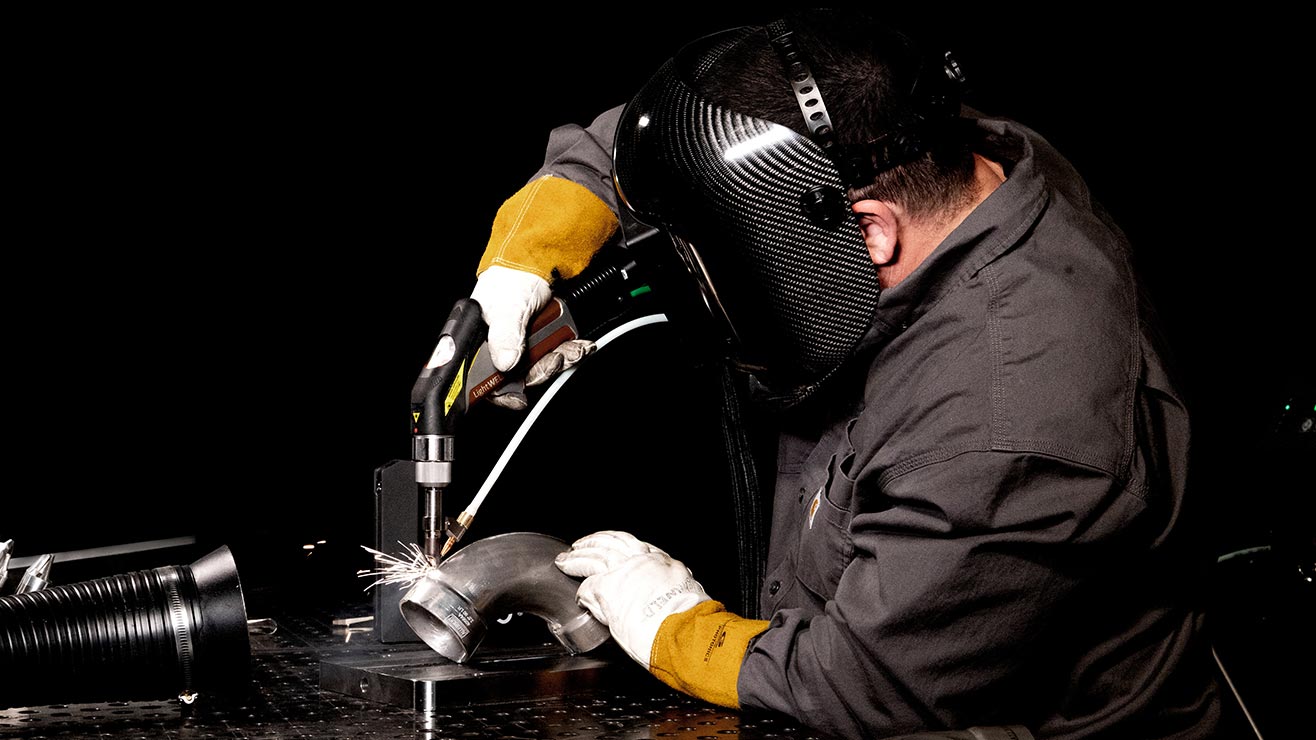10 Steps to Achieve Handheld Laser Welding Success

Despite being adopted by thousands of fabricators and businesses around the world, handheld laser welding is still relatively new to the industry, particularly compared to its more established MIG and TIG cousins.
That means that while the benefits of the technology – such as increased productivity, reduced distortion, and ease of use – are straightforward, successful implementation is not always simple.
Without decades of institutional traditional welding experience to fall back on, reaping the benefits of laser welding means understanding how to plan for success (and avoid common pitfalls). Here are 10 steps to ensure you’re getting the most out of laser welding.
#1. Define your motivation (and know the limits)
Handheld laser welding is a game-changer that comes with more benefits than can be reasonably discussed in a single article. But welding with light is about more than just buying a new tool – it’s about optimizing a new process. That means you need to understand how it works and what you are trying to accomplish.
Before you bring in a new laser welder, it’s essential that you understand why. Here are some common motivations:
- Improving weld quality on thin or cosmetic parts
- Reducing post-weld grinding and cleanup
- Decreasing reliance on fixtures, clamping and pre-weld setup
- Training new employees faster and more effectively
- Reducing labor, consumable, or electricity costs
- Winning more jobs with faster turnaround
- Achieving improved weld to weld consistency
Whatever your motivation, it’s important to understand that laser welding isn’t a one-size-fits-all solution. Not every operation will be able to replace 100% of their MIG and TIG welding with laser welding.
Unlike MIG or TIG, laser welding is not well-suited for wide gaps and poor part fit up. Although beam wobble modes and various wire configurations do a lot to bridge gaps, laser welding relies on tight, consistent joints to deliver optimal results.
From a practical standpoint, this means you may need to redesign joint configurations or tighten tolerances in your cutting, bending, and fixturing steps. Engaging your team early in the process will make it easier to identify quick wins and potential challenges.
#2. Choose an equipment champion
While this advice is meant for team leaders at multi-person facilities, it is still valuable for individual welders and one-man operations (such as metal art studios).
We’ve seen it far too often. A shop manager gets excited about laser welding just to unbox their new laser welder and let it sit under-utilized in a corner. It’s not caused by a lack of use cases – it’s an issue of educating and motivating a team to use new tools and processes.
That’s why it’s a good idea to choose an equipment champion. Your champion is someone willing to serve as an in-house expert on laser welding. At the minimum, that means that they understand how to use the machine, how to maintain it, and are committed to following laser safety best practices.
Your equipment champion can be yourself or anyone enthusiastic about laser welding. Whoever you choose should have good leadership skills and be willing to train other welders and ensure consistent use. Ideally, this individual can also help coordinate as needed with your designers and engineers as well as production and maintenance staff.
It is worth noting that your equipment champion and your Laser Safety Officer (LSO) may or may not be the same person. While it’s not a particularly complicated role to play anywhere but in the most large-scale manufacturing environments, an LSO is ultimately responsible for training team members on laser safety and ensuring that the shop floor is sufficiently equipped with PPE and a laser-safe welding area.
#3. Identify early resistances
A motivated equipment champion goes a long way, but you may find that not everyone on your team matches their enthusiasm.
It’s understandable – handheld laser welding is a new player in the world of welding and change is tricky, even under the best of circumstances. To make things more complicated, online marketing claims (some true and some not) have led to healthy skepticism about laser welding’s capabilities, safety, and legitimacy.
The following are some common sticking points and ways to address them.
Ease of use
Challenge: Laser welding is generally considered easier to learn than MIG and particularly TIG. This can make veteran welders feel less valuable or like their jobs are in danger.
How to address it: Ensure your welders know that laser welding is another tool in their toolbox. At the end of the day, it’s better than MIG and TIG at some things and worse at others. Laser welding is another skill to learn – not a replacement for skilled labor.
Safety
Challenge: Safe laser welding requires some different considerations and equipment than traditional welding. Strict adherence to safety best practices is essential for avoiding burns and eye damage.
How to address it: Education is critical – you and/or your LSO are responsible for educating all relevant employees about laser welding safety. Beyond that, make it clear that the chances of injury are low if basic steps are taken and simple PPE is worn.
Consult these safety resources for everything you need to know about laser welding safety.
Capabilities
Challenge: New welding processes have a history of drawing welder skepticism and laser welding is no different. For those who don’t know a lot about it, handheld lasers may look like a fad, even if automated laser welding has been a key part of industrial fabrication for decades.
How to address it: Encourage welders to spend a little time researching laser welding. The internet is full of technical deep dives and success stories that should help increase their confidence.
If that doesn’t work, nothing beats putting them behind the torch to make a couple of welds (and testing weld strength with a hammer, if necessary).
#4. Launch a pilot program
If possible, start small. Choose a few well-defined parts or kinds of welds that are good candidates for laser welding. Good application candidates likely have one or more of the following characteristics:
- Stainless steel or mild steel
- Thin to medium gauge
- Good, repeatable fit up
- High quality and/or consistency requirements
- Labor intensive with MIG or TIG
Once you’ve picked your part(s), set some measurable goals such as reduction in weld time, improved appearance, or decreased post-weld grinding.
A good pilot program will run long enough to expose variability, be it in part tolerances, operator skill, and maintenance requirements. Don’t rush this part – we recommend setting aside at least two weeks and ideally as many as six.
#5. Train for skill, not just operation
Although laser welding requires less practice and manual dexterity than arc welding, it is still a new skill. It is a good idea to find time for structured hands-on training, which can be led by your equipment champion or the manufacturer of your equipment.
For skilled welders, it is helpful to start with the key differences between traditional welding and laser welding:
- There is no arc to control. Laser welding uses photons (rather than electrons) and the sound, appearance, and overall feeling of the process can take some getting used to.
- There is new terminology to learn and settings to understand. For example, the laser’s output is controlled by adjusting power versus voltage and amperage on an arc welder. Another example: results like weld width are controlled by wobble (beam oscillation) settings rather than hand movements.
- Laser welding is usually several times faster than MIG or TIG welding and it requires proper body positioning and anticipation of the weld path to maintain consistent speed.
- Unlike MIG or TIG, which can support a wide variety of torch angles, laser welding torches should be held at a consistent angle (between 30° and 70° relative to the workpiece) throughout the welding process.
Inevitably, you or your team will have questions. If in doubt, don’t hesitate to reach out to the manufacturer for guidance.
#6. Plan for new maintenance needs
Handheld laser welders have different upkeep requirements than MIG or TIG systems. While laser welders often reduce consumable costs across the board you will need to get used to a new set of maintenance tasks.
One often forgotten task is changing the cover lens. This small piece of glass, which is easily accessible in the torch, protects the rest of your equipment’s optics. Regular use will degrade the lens – failure to change a spent lens will lead to unpredictable performance (typically underpenetration).
Heavy use might necessitate replacement every shift, although it’s more typical to go through one or two cover lenses per week.
Other parts of your machine, such as the focus lens or fiber, may occasionally require service as well. These elements are comparatively long-lasting but unexpected issues can still be disruptive.
#7. Create a backup plan
Laser welding is very potent in the right hands and when used in the right applications. That can lead to parts and processes that rely entirely on a single machine.
Unfortunately, this is the perfect recipe for a big problem in the event of unplanned downtime. When laser welding is a critical production step, even a short outage can bottleneck your workflow.
Here a few ways you can reduce your risk:
- Train multiple team members on basic equipment troubleshooting
- Work with your supplier to ensure loaner access or rapid service
- Maintain a backup machine, especially for high-priority jobs
#8. Rethink your fixturing
As we’ve mentioned, laser welding isn’t a one-to-one replacement for MIG or TIG. Laser welding’s speed, precision, and minimal heat input can reshape how you approach things like fixturing.
Traditional welding often requires heavy-duty multi-point clamping to handle distortion, part movement, and torch accessibility.
Here’s how laser welding can change things.
Reduced clamping requirements: Because laser welding dramatically reduces distortion, you may no longer need large fixtures with multiple clamps or supports. In many cases, lightweight or modular fixtures are enough, especially for small parts or thin materials.
Increased alignment requirements: While you may need smaller or fewer clamps, the way you use them might need to change. Laser welds are narrower and more focused so fit up and alignment become more important. For the best results, your fixtures should offer good control over gaps, edge consistency, and alignment.
Faster cycle times: With welding speeds several times faster than those of MIG or TIG, your fixture changeovers may become a new bottleneck. Utilizing quick-release, tool-less, or modular fixtures can help you match the speed of your new process.
Fewer non-welding steps: Laser welding often eliminates the need for weld prep like edge beveling and can drastically reduce post-weld grinding. That means your fixture designs can potentially be simplified since you no longer need to compensate for those extra steps.
#9. Measure, adjust, and scale
It’s one thing to “feel” the benefits of laser welding in your day-to-day. It’s another to truly measure what it’s doing for you.
Whether it’s right after your pilot program or at the conclusion of a big project, it’s rarely a bad time for some objective analysis.
Ideally, you should find ways to collect both numerical data and welder feedback to paint a full picture.
Try to measure improvements in areas like:
- Weld time (per unit, if you have multiple)
- Total labor hours
- Post-weld cleanup or grinding time
- Weld quality and rework rates
- Consumable consumption
And talk to your welders about:
- What worked for them – and what didn’t
- Successes and challenges
- Safety measures
- Training and skill development
- New potential use cases
There’s a lot you can do once you have some data. Refining before scaling is essential, so if there are areas of improvement it’s worth working on those first.
Once you’ve optimized existing processes, you may find that there are more parts, work cells, or even product lines that can benefit from laser welding. You’ll need to consider what kind of resources you need including staff, space, and equipment. And you’ll need to identify potential changes to existing factors like part tolerances, fixturing, and training.
Remember, while there’s no blueprint for successfully integrating handheld laser welding across your organization, you’re also not alone. Others have already done it. Consider reaching out to your manufacturer – they may have some real-world insights or be able to put you in touch with successful customers in your industry.
#10. Consider the long term
Handheld laser welding should be more than a fancy piece of equipment – it should be a strategic investment in your operation’s future. Once your team has adopted the technology and proven its value, it’s time to think long term.
Grow where you’re comfortable: There’s no shame in going after the low hanging fruit. For many, laser welding is a straightforward upgrade to legacy processes. It’s rarely a mistake to use the increased productivity to enjoy higher margins, quote lower prices, or take on higher volume jobs.
Stand out from the competition: Handheld laser welding is not yet in the hands of every welder and fabricator. For now, it offers capabilities that help you stand out from your competition (whether that means tighter tolerances, cleaner aesthetics, or faster turnarounds). Use that to position yourself as a high-tech, high-performance provider.
Expand your market: Laser welding can open the doors to new industries or markets (food grade stainless steel, for example). It also allows for finer control in applications where distortion or spatter are unacceptable. You may discover you are better positioned to serve new kinds of customers or even carve out a niche for your business.

